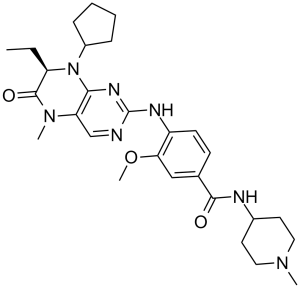BI 2536
This product is for research use only, not for human use. We do not sell to patients.

For small sizes, please check our retail website as below: www.invivochem.com
| Size | Price | Stock |
|---|---|---|
| 250mg | $850 | Check With Us |
| 500mg | $1350 | Check With Us |
| 1g | $2025 | Check With Us |
Cat #: V1573 CAS #: 755038-02-9 Purity ≥ 98%
Description: BI2536 (BI-2536; BI 2536) is a novel PLK1/BRD4 dual inhibitor with potential antitumor activity.
Top Publications Citing Invivochem Products
Publications Citing InvivoChem Products
Product Promise

- Physicochemical and Storage Information
- Protocol
- Related Biological Data
- Stock Solution Preparation
- Quality Control Documentation
| Molecular Weight (MW) | 521.66 |
|---|---|
| Molecular Formula | C28H39N7O3 |
| CAS No. | 755038-02-9 |
| Storage | -20℃ for 3 years in powder formr |
| -80℃ for 2 years in solvent | |
| Solubility In Vitro | DMSO: 21 mg/mL (40.3 mM)r |
| Water: <1 mg/mLr | |
| Ethanol: 100 mg/mL (191.7 mM) | |
| Solubility In Vivo | 30% PEG 400+0.5% Tween 80+5% Propylene glycol: 15mg/mL |
| Synonyms | BI2536; BI-2536 BI 2536 |
| Protocol | In Vitro | Beyond the 10-fold concentration range starting at 100 nM, BI2536 causes HeLa cells to accumulate at 4N DNA content, indicating cell cycle arrest in the G2 phase or mitosis. In addition to HeLa cells, BI 2536 potently inhibits the proliferation of a group of 32 human cancer cell lines representing different organ-derived (including breast, colon, lung, pancreatic and prostate, melanoma, and hematopoietic system cancers) and a wide variety of modalities of tumor suppressor or oncogene mutations (including RB1, TP53, PTEN, and KRAS). status). Half of the maximum effective concentration (EC) of this cell group50Values range from 2-25 nM, while BI 100 at a concentration of 2536 nM is usually sufficient to induce complete mitotic arrest. Proliferation of exponentially growing hTERT-RPE1, human umbilical vein endothelial cells (HUVECs), and normal rat kidney (NRK) cells at 12-31 nM EC50 The range of values is blocked, indicating circulation with untransformed cells to BI 2536. |
|---|---|---|
| In Vivo | BI 2536 (40-50 mg/kg, iv) blocks the growth of human cancer xenografts in immunodeficient nu/nu mice. Consecutive cycles of 40-50 mg/kg BI 2536 intravenously once or twice weekly were found to be highly effective in different xenograft models, such as HCT 116 colon cancer with complete tumor suppression with a twice-weekly schedule (treatment versus once-weekly treatment control (T/C) value of 0.3%, T/C value of 16%; Both regimens were well tolerated by clinical signs and the absence of significant weight changes. |
These protocols are for reference only. InvivoChem does not
independently validate these methods.
| Solvent volume to be added | Mass (the weight of a compound) | |||
|---|---|---|---|---|
| Mother liquor concentration | 1mg | 5mg | 10mg | 20mg |
| 1mM | 1.9170 mL | 9.5848 mL | 19.1696 mL | 38.3391 mL |
| 5mM | 0.3834 mL | 1.9170 mL | 3.8339 mL | 7.6678 mL |
| 10mM | 0.1917 mL | 0.9585 mL | 1.9170 mL | 3.8339 mL |
| 20mM | 0.0958 mL | 0.4792 mL | 0.9585 mL | 1.9170 mL |
The molarity calculator equation
Mass(g) = Concentration(mol/L) × Volume(L) × Molecular Weight(g/mol)
Mass
=
Concentration
×
Volume
×
Molecular Weight*
The dilution calculator equation
Concentration(start)
×
Volume(start)
=
Concentration(final)
×
Volume(final)
This equation is commonly abbreviated as: C1 V1 = C2 V2
Concentration(start)
C1
×
Volume(start)
V1
=
Concentration(final)
C2
×
Volume(final)
V2
Step One: Enter information below
Dosage mg/kg
Average weight of animals g
Dosing volume per animal µL
Number of animals
Step Two: Enter the in vivo formulation
%DMSO
+
%
+
%Tween 80
+
%ddH2O
Calculation Results:
Working concentration:
mg/ml;
Method for preparing DMSO master liquid:
mg
drug pre-dissolved in
µL
DMSO(Master liquid concentration
mg/mL)
,Please contact us first if the concentration exceeds the DMSO solubility of the batch of drug.
Method for preparing in vivo formulation:
Take
µL
DMSO master liquid, next add
µL
PEG300, mix and clarify, next add
µL
Tween 80,mix and clarify, next add
µL
ddH2O,mix and clarify.
Note:
- (1) Please be sure that the solution is clear before the addition of next solvent. Dissolution methods like vortex, ultrasound or warming and heat may be used to aid dissolving.
- (2) Be sure to add the solvent(s) in order.




































